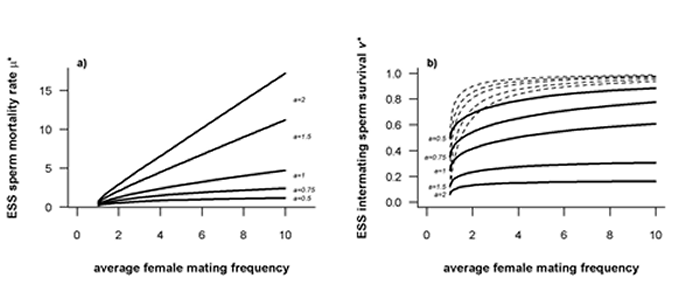The evolution of male fertility
Fertilization success is decisive for how many offspring a male will sire. Traits increasing the competitive ability of male sperm should be strongly favoured by selection, eliminating variation in sperm number and type. It is therefore surprising that differences in male fertility are widespread in nature, both between and within species. How can we explain this variation from an evolutionary point of view? In my recent research, I have focused on some of the open theoretical questions associated with the evolutionary processes influencing male fertility. Here I describe the results from two recent projects.
Sperm competition (i.e. the competition between sperm from two or more males for the fertilization of a given set of ova) has been identified as a strong selective force shaping the evolution of many male reproductive traits. In the first project, I investigated whether and how sperm competition should affect sperm viability. The longer a male's sperm can survive, the longer they can participate in the competition for egg fertilization. Following the logic that male sperm traits will be more important at high levels of sperm competition, it has repeatedly been suggested that the benefit of high sperm survival should increase with an increasing level of sperm competition. However, there is at present no theoretical analysis of this hypothesis. I therefore used an evolutionary game-theory approach to find the evolutionarily stable strategy (ESS) with respect to male investment in sperm viability.
The most important result of this analysis was that the ESS sperm mortality rate will increase with an increase in female mating rate, thus leading to less viable sperm (Figure 1). Hence, in matings systems, where females mate with many males, sexual selection is predicted to drive sperm viability to lower levels compared to mating systems where females mate less frequently. This might at first glance seem as a highly unreasonable result. How can we make more sense out of this prediction? If females mate frequently, males are very likely to face sperm competition. Investing in highly viable sperm is analogous to investing in future fertilization opportunities. However, when females have a high remating rate, these future fertilization chances will be decreasingly small because a male’s sperm will compete against an increasing number of rival sperm. Hence, the more males a female will mate with in the future, the less beneficial it will be to invest in viable sperm that can fertilize eggs in the future. On the other hand, if females mate at a very low frequency, most male matings will be with virgin females. Sperm will thus be less important for male reproductive success. Here the only reason to invest any excessive energy in sperm is for them to survive long enough until the female remates and sperm competition does occur. These novel results should have strong impact on future sperm competition studies and will also have strong implications for our understanding of the evolution of female mating rate.

In the second project, I investigated how intrinsic differences in male fertility should affect a male’s investment into any given ejaculate. Variation in male fertility is common and, for example, caused by selfish genetic elements or the accumulation of deleterious mutations with male-specific effects in mitochondrial DNA ('mother's curse' mutations). Yet, most theoretical analyses of sperm competition assume that all males within a population have the same fertility. I dropped this assumption, in order to answer the question: should males that are intrinsically less fertile compensate and invest more in sperm traits, or instead concentrate investment on traits affecting mating success?
My theoretical analyses have revealed that differences in male fertility can have large effects on overall male sperm investment. In a first model, I assumed that males do not know their intrinsic fertility and, hence, cannot make their ejaculate investment dependent on their own fertility. For this scenario, I could show quite generally that in populations with larger variation in male fertility, fewer resources should be spent on ejaculates. The reason for this is that as inter-male fertility differences become larger, fertilization success will be less influenced by ejaculate investment; instead intrinsic male fertility will dictate sperm competition success. In contrast, when all males are equal, ejaculate investment is the only influencing factor, and males are expected to invest more. In a second model, males were able to allocate resources on sperm investment dependent on their own fertility. In this scenario, the model predicts that less fertile males should compensate their disadvantage by investing more in sperm competition, unless differences between males are very large.
